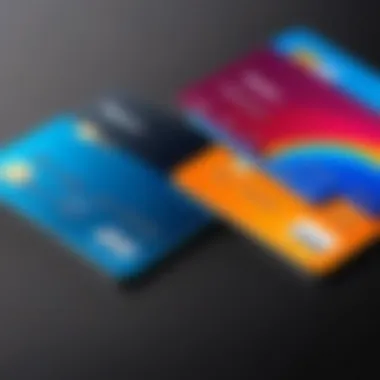Understanding Square's Credit Card Acceptance Policies


Intro
Credit cards have become a primary method of transaction in contemporary commerce. This portfolio is essential for both businesses and consumers wanting flexibility in payment options. Square holds a significant position within this ecosystem by providing a seamless payment processing solution for various user demographics. Understanding Square's credit card acceptance and the nuances related to it is vital for merchants seeking an efficient method to handle payments while enhancing customer satisfaction. In this overview, we will examine essential features, appreciate the pros and cons of the platform, discuss its pricing strategy, and draw expert conclusions about its efficacy in meeting diverse users' needs.
Software Overview
Features and functionalities overview
Square’s payment processing system is designed with a focus on ease of use and accessibility. It supports various credit cards including Visa, MasterCard, American Express, and Discover. Users benefit from a myriad of functionalities, which include payment processing through in-person and online avenues, invoicing, inventory management, and analytics on sales performance. The design and feature set appeal to small businesses and large enterprises alike, accommodating various operational needs with robust performance.
User interface and navigation
Navigating through Square’s software is straightforward. Visual clarity enhances user experience, allowing even those who are not tech-savvy to manage transactions with minimal training. There is a responsive and intuitive layout for both the mobile and smartphone applications of Square. Essential functions, like payment acceptance and reporting, are readily accessible—demonstrating thoughtful design for basic liquidity needs.
Compatibility and integrations
Square offers compatibility with multiple operating systems, which includes iOS, Android, and desktop platforms. Moreover, it integrates seamlessly with financial software solutions such as QuickBooks and Xero making it easier for accounted transactions. The ability to sync with e-commerce platforms like Shopify extends its function, supporting various business models.
Pros and Cons
Strengths
- Wide acceptance of credit cards: Square accommodates a range of widely used credit cards, simplifying the process for users.
- User-friendly interface: Ease of navigation contributes positively to operational efficiency.
- Seamless integrations: Support for a multitude of third-party applications expands its usability.
Weaknesses
- Processing fees: The transactional fees may be a point of contention for businesses processing high volumes.
- Geographical limitations: Some features might not be available in all countries, which can affect global operators.
- Customer service: There are varying accounts of customer service experiences, which could be improved.
Comparison with similar software
When juxtaposed with other platforms like PayPal or Clover, Square presents unique strengths in straightforward integration and a robust user interface. However, processing fees on each transaction could be higher than PayPal, which may be a factor for businesses focused on margins.
Pricing and Plans
Subscription options
Square operates a dual pricing model. Users can opt for a freemium model that allows them to start without upfront fees. Transactional fees apply on each payment. The premium plans introduce monthly subscriptions with added features—much suitable for larger or more specialized businesses.
Free trial or demo availability
Currently, Square does not offer a formal free trial. However, users can start using the service with basic features immediately, providng a no-risk assessment.
Value for money
Many users consider Square’s pricing competitive, especially with no hidden fees. With the range of services provided, it often aligns with the needs and budget constraints of small to mid-sized businesses.
Expert Verdict
Final thoughts and recommendations
In evaluating Square, its integrated ecosystem can be very advantageous for businesses, particularly those aiming for rapid adoption and intuitive usage. Thus, Square comes highly recommended for small to midsize enterprises that prioritize ease of use without compromising on fundamental performance features.
Target audience suitability
Businesses in retail, quick service restaurants, and even mobile vendors can experience great benefits from Square’s user-friendliness and comprehensive credit card acceptance capabilities. Understanding how these functions align with their business requirements is crucial.
Potential for future updates
Square is positioned competitively within the industry. With its metrics on support and operations moving generally positive, continuous improvement is likely, especially in addressing customer relations and potential international expansion. As technology evolves, Square’s offerings may renew to incorporate more features that keep it abreast of newer competitors in the payments landscape.
Understanding credit card acceptance is critical for leveraging payment methods and improving sales performance. Square makes strides in this domain, setting a standard in payment processing technology.


Overview of Square Payment Processing
Square has emerged as a vital player in the landscape of payment processing, offering robust solutions for businesses of all sizes. This section will emphasize its functionality, focusing on key aspects that make Square a desirable choice for credit card acceptance. Understanding how Square operates serves not just transaction-related functions but also impacts overall business efficiency and customer experience.
To engage customers effectively, businesses need to streamline payment processes. One essential way to do this is through accepting various forms of payment, specifically credit cards. Square provides this capability with minimal setup time and straightforward procedures, allowing enterprises to focus more on their core operations rather than the minutiae of payment processing. Further, adaptability to trends increases the appeal of including Square's services for businesses aiming for agility.
What is Square?
Square is a complete payment processing platform, known for its intuitive design and user-friendly capabilities. It was founded in 2009, with the aim of simplifying the transaction process for small businesses. Primarily known for its small, credit card readers, Square also offers powerful software tools that help vendors manage sales, track inventory, analyze data, and engage with customers. It primarily suits small to medium-sized businesses that desire easy-to-use solutions for their transactions.
Database management and fetching useful statistics are foundational to Square's promise. More than just a payment processor, Square allows users to monitor customer behavior and better understand sales patterns, adding more value than mere transaction credits. The analytics work quickly to guide business decisions, which can help enterprise growth, while at the same time optimizing payment acceptance.
How Square Works in Payment Processing
Square operates by allowing merchants to accept credit cards electronically. Fundamentally, the process first requires the integration of Square’s Point of Sale system. This can be done through the Square app on a smartphone or by using hardware components like Square Stand or Terminal. Processing payments starts with dipping or swiping a credit card or entering card details manually into the app.
Once a customer decides to pay with their card, Square performs a series of tasks in the background. It securely encrypts the transaction data, sends the information to the bank for authorization, and finally instructs the payment terminal to complete the sale upon approval. Transaction completion seamlessly pulls funds into the merchant’s account, typically within a few business days. This technology-centric simplicity underlines a critical element of Square's offerings — the speed with which payments are processed, which can have a larger impact on sales operations.
Square can provide a competitive edge through faster payment solutions for businesses.
Moreover, Square cuts through the complexity usually associated with payments, which are often laden with processing challenges. For tech-savvy users, its developer-friendly API offers potential customization that fits directly into existing systems. Many third-party integrations complement the performance of Square, establishing it as a suitable fintech solution.
Accepted Credit Cards
The acceptance of credit cards is a critical aspect of running a business today. For businesses utilizing Square for payment processing, understanding credit card acceptance is essential. It directly influences consumer purchases and overall sales performance. Different forms of payment provide various opportunities and challenges.
Benefits are numerous. Accepting credit cards broadens the potential customer base. Many consumers prefer to pay via card for convenience and security. Not utilizing credit card processing can lead to lost sales, particularly in an increasingly cashless society. Businesses thus benefit by improving customer ease while increasing revenue.
Understanding considerations related to accepted cards is also vital. Each credit card network has its own rules, guidelines, and fee structures. This ensures businesses are well informed on which options work best for them, thereby customizing their processes.
With Square, businesses can leverage the power of popular credit cards while enjoying integrated features that enhance overall efficiency.
Major Credit Card Brands Supported by Square
Square recognizes the ubiquity and popularity of certain credit cards in today’s market. Consequently, it supports various major credit card brands, which include Visa, Mastercard, American Express, and Discover. Each card brand comes with its own advantages and customer demographics, making all of them relevant.
- Visa: A global giant, known for its widespread acceptance.
- Mastercard: Competes closely with Visa, facilitating a large volume of transactions globally.
- American Express: Targeted often towards premium consumers; it typically has a higher transaction fee.
- Discover: To a lesser extent utilized but still valuable for specific markets.
Businesses benefitting from Square thus cover a diverse range of clients. Acceptance of these major brands serves to provide payment flexibility and confidence for consumers.
Square's decision to engage with multiple brands underlines its commitment to meeting market demands. Constantly assessing credit card landscapes ensures businesses stay relevant with upbeat consumer trends.
Debit Cards: Are They Included?
When it comes to payment methods, debit cards play a substantial role. Square acceptsi debit cards to its customer-friendly approach. This feature allows businesses to cater to customers who prefer using funds directly linked to their bank accounts, rather than credit.
Security is a strong suit of debit card usage. For many, payments made directly from bank accounts create a perception of lower risk. Moreover, selecting from both credit and debit brings more versatility. Customers then have the choice, enhancing their shopping experience.
It is important for a business to realize is that debit cards are subject to overall transaction mechanics. With Square's simple interface and seamless integration, many see improved efficiency for handling various forms of payment. And for vendors, the potential costs align and integrate well with their systems. Thus, allowing for manageable reviews in tracking expenditures.
Square's Compatibility with Digital Wallets
Integrating digital wallets into payment processing solutions enhances both convenience and security for businesses and customers. Square recognizes the growing trend and importance of these integrations, providing users with a range of options. With more consumers opting for nontangible payment methods, Square's compatibility with digital wallets becomes essential.
The key benefits of integrating digital wallets are primarily seen in terms of transaction speed and consumer experience. Digital wallets simplify the payment procedure, often enabling one-click payments. This is particularly advantageous for mobile users who may prefer to transact instantly on their devices. Accepting popular digital wallet solutions through Square ensures potential transactions are not hindered by payment friction, thus increasing conversion rates for businesses.
However, it is important to consider compatibility with different digital wallets. While Square supports a variety of platforms, integrating them correctly is critical for optimal performance. Hence, Square also emphasizes the training and ongoing management required to maximize the effectiveness of these digital transactions.
The following subsections will examine the specific integrations available:
- Integration with PayPal
- Apple Pay and Google Pay Compatibility


Understanding these specifics adds depth to how businesses leverage Square to broaden their payment capabilities, adapt to consumer preferences, and improve overall transaction success.
Using digital wallets with Square helps to capture a broader customer base while improving user satisfaction during checkout.
Integration with PayPal
PayPal is one of the leading digital payment platforms worldwide. Its integration with Square means that businesses can offer their customers an additional payment method, appealing particularly to online shoppers. This collaboration is straightforward and requires minimal setup. PayPal accounts are widely used, allowing users to conduct transactions without the need to input credit card details every time.
In practical terms, with Square supporting PayPal transactions, businesses stand to benefit from increased sales across a wider audience. Consumers can pay directly through their PayPal accounts, either using available funds or linked cards.
It’s vital for businesses to be aware of the associated fees with PayPal transactions. While integrating PayPal provides advantages, laying out these costs transparently ensures long-term satisfaction with both consumer and business partners.
Advantages of Using PayPal with Square:
- Widespread Recognition: Many people trust PayPal, enabling higher conversion.
- User-Friendly: Simple processes for established PayPal users lead to easier transactions.
- Enhanced Security: Users do not have to share credit card info directly with merchants.
Considerations:
Businesses should ensure they understand the fee structure associated with PayPal payments and how these might impact their bottom line. Additionally, occasional technical issues may arise, so it is vital to have measures in place for addressing potential transaction disruptions.
Apple Pay and Google Pay Compatibility
Apple Pay and Google Pay continue to reshape the transaction landscape by introducing additional the easy of use. Square's compatibility with these digital wallets allows business owners to cater to a dominant trend in payment behaviors today.
Both of these wallets offer a streamlined process where consumers can pay discreetly and instantaneously from their smartphones. For businesses, it is essential to integrate these wallet services because many consumers are beginning to prefer contactless payments, especially in environments focused on health, safety, and quick service.
Furthermore, the ease with which transactions are conducted via Apple Pay or Google Pay helps facilitate impulse purchases, a significant advantage for retailers and service providers.
Hard Benefits of Offering Apple Pay and Google Pay with Square:
- Increased Transactions: The swiftness of mobile transactions often adds to higher average purchase amounts.
- Reduced wait time: Quick payment options improve customer satisfaction by reducing queues.
- Branding Benefits: Enhanced technical reputation amongst targeted consumer populations.
Security Aspects:
Both digital wallets utilize tokenization to enhance payment security. This means that customers’ card information remains safe from breaches during an exchange, making these options increasingly attractive from both a usability and security perspective.
Adopting digital wallets through Square keeps businesses equipped to respond to evolving consumer behaviors, all while maintaining a competitive edge within their respective industries.
Processing Fees and Financial Considerations
The topic of processing fees and financial implications is crucial when discussing Square’s credit card acceptance. Understanding this aspect helps businesses to manage their margins effectively. Additionally, it reveals how Square compares to other processing options in terms o costs and, ultimately, profitability for user businesses. Thus, knowing the fee structure is essential for budgting decisions.
Understanding Square’s Fee Structure
Square operates on a straightforward fee structure, noteworthy for its simplicity and transparency. As of now, Square charges a fixed percentage for each transaction, specifically 2.6% plus 10 cents for in-person card transactions. Online transactions, meanwhile, often carry a different rate of 2.9% plus 30 cents. Given Square's lack of monthly fees or contracts, users can pivot easily.
It's important to mention that these fees can vary depending on several factors, such as the payment method or currency. Businesses should evaluate these rates, especially if they process high volumes or larger transactions. Assessiong these costs thoroughly aids business owners in forecasting their expenses accurately, offering a vital insight into net earnings after transactions.
Comparative Analysis with Other Payment Processors
When compared with other payment processors, Square’s fees position it in a competitive light. PayPal, for instance, charges a similar percentage but may pair this with withdrawal fees. In contrast, Stripe and Shopify Payments also offer competitive rates but may compel users to commit to monthly accounts for lower fees.
To compare, let’s highlight few points:
- Transparency: Square doesn’t impose hidden fees, making it reliable.
- No Monthly Fees: Guaranteed access to payment processing, without holding businesses to long-term contracts.
- Customer Service: Square supports its users adequately, improving the overall experience compared to confusing competitor support channels.
- Mix of Features: Square offers tools to integrate sales, inventory and data analysis unlike some platforms focused solely on payments.
In the growing digital marketplace, businesses must weigh both costs and functionaility when selecting a payment processor. Delving into these factors arms companies with the knowledge to make informed decisiions that enhance overall financial performance. By thoroughchecking options such as Square’s options, users can find a path that suits their lucrative needs.
Setting Up Square for Credit Card Payments
Setting up Square for credit card payments is crucial for businesses that aim to streamline the payment process. This section provides a focused look at key elements necessary for a successful setup. Proper setup not only facilitates smooth transactions but also enhances customer experience. Furthermore, understanding how to effectively use Square can lead to improved financial management for your business. By optimizing your payment process from the start, you can reap long-term benefits such as efficiency and reliability.


Initial Setup Process
The initial setup with Square needs to be direct yet thorough. Begin by creating an account on the Square website. This is where you will have to provide your email address, preferred password, and some basic information about your business.
Once your account is active, it is essential to integrate the necessary hardware if you plan to accept credit card payments in person. Common options include the Square Reader for magstripe payments and the Square Stand for a complete point-of-sale solution.
To accept payments online, utilize the Square web application or integrate Square's API into your existing website or app. This allows developers to customize the payment process and user interface. Here are the general steps to follow:
- Create and verify your Square account.
- Select a preferred payment processing method.
- Configure your hardware and software.
- Connect to your bank account for fund deposits.
This initial preparation sets a foundation for effective transaction handling.
Ongoing Management of Payment Options
Once your setup is complete, managing the payment options effectively becomes the next step. Keeping track of various features offered by Square ensures you provide updated payment channels to your customers. You should consistently review your settings within the Square Dashboard.
It’s vital to stay updated about new credit card types and compatibility with your Square system, as financial environments change.
Additionally, consider regularly revisiting your fee structure. This can help optimize costs associated with payment processing, ensuring you don’t incur unnecessary charges. Using Square ensures you are notified about updates and new features available on the integrated platforms.
Key management tasks include:
- Regularly update your software. Ensures security and access to new payment options.
- Monitor transaction fees. Analyzing these helps manage your overall business expenditure.
- Adjust your payment menus. Tailor payment options to capture changing consumer preferences.
Effective management can significantly enhance customer satisfaction and encourage repeat business.
Efficiency in your payment solution closely correlates with the customer experience.
Security and Compliance
In today's digital financial landscape, security and compliance are paramount. Considering the sensitive nature of financial transactions and consumer data, knowing how Square addresses these factors is essential for users. This section outlines the security measures Square employs and how it complies with industry standards. Understanding these elements is crucial for businesses that prioritize customer trust and stability.
Square's Security Measures
Square has implemented a multifaceted approach to ensure secure transactions. This involves both technological and procedural safeguards. Here are some key points of Square's security framework:
- Data Encryption: Square encrypts sensitive card information using industry-standard encryption technologies. This ensures that information remains confidential during transactions.
- Secure Networks: All transactions through Square occur over secure and private networks. This mitigates risks associated with data interception.
- Fraud Detection: Square employs advanced algorithms to identify potentially fraudulent transactions. Unusual transaction patterns flag to Square’s systems, prompting further review.
- User Account Security: Square requires users to set strong, unique passwords. Additionally, two-factor authentication is highly recommended to add an extra layer of security against unauthorized access.
Ensuring security doesn’t just protect the users but reinforces the overall trust in the platform. By focusing on risk and maintaining a robust security strategy, Square offers businesses a secure environment for accepting payments.
Compliance with Industry Standards
Compliance with industry standards is as crucial as security measures. Square adheres to several important regulations and standards:
- PCI DSS Compliance: Square measures conform to the Payment Card Industry Data Security Standards. This means they maintain strict standards for processing cardholder data.
- Regulation Compliance: As a payment processor, Square complies with federal and state regulations governing financial transactions, ensuring they follow legal guidelines.
- Updates and Audits: Square regularly undergoes audits to ensure ongoing compliance with evolving standards. Keeping pace with regulatory changes is necessary for maintaining integrity.
The already outlined features signal that Square takes security and compliance seriously. All transactions processed through Square not only safeguard user data but also align with practice standards within the payment processing industry.
In summary, Square's commitment to security and compliance is instrumental in establishing a safe transaction environment for users. By safeguarding data and adhering to regulatory requirements, Square promotes trust and reliability among businesses and their customers.
Closure and Key Takeaways
The Importance of Choosing the Right Payment Processor
Choosing the right payment processor is a critical decision for any business. It impacts your operational efficiency and customer satisfaction. Square offers seamless integration, diverse payment options, and user-friendly systems.
Several factors influence this choice:
- Fees: Understanding Square’s fee structure helps determine financial viability for your business model.
- Compatibility: The ability to integrate with other platforms like e-commerce sites or accounting software streamlines processes.
- User Experience: Courteous and hassle-free payment processing corresponds to higher customer retention.
Each of these elements contributes significantly to a positive customer experience and ensures your business operates smoothly.
Final Thoughts on Square's Credit Card Acceptance
Square simplifies credit card acceptance, which is attractive for businesses of all sizes. Its support for various major credit cards caters to customer preferences. Square excels in providing straightforward interface and effective management tools.
As such, this platform remains competitive within the payment processing landscape. Other options may offer different features, but Square’s adaptability and transparency in fees enhance its appeal.







